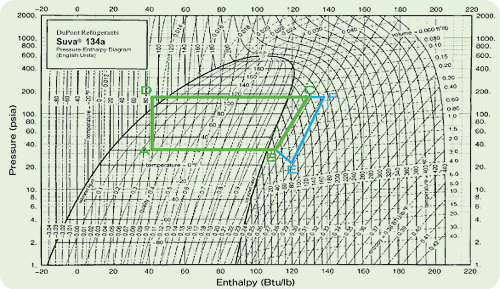The P-H diagram is a graphical representation of the refrigerant as it travels through the refrigeration system. It can be used to predict several system conditions, such as the pressure and temperature for the refrigerant at various locations within the system. It can also be used to demonstrate the effects of system changes to these conditions.
For example, it can be used to predict the approximate discharge temperature of the refrigerant leaving the compressor. It can demonstrate how an excessive suction line pressure drop and excessive return vapor temperature can cause an increase in the discharge temperature.
Each refrigerant has its own unique P-H diagram. Figure 1 shows a P-H diagram for R-134a.
Lines A, B, C, and D represent the status of the refrigerant as it travels through a sample system. Line C-D represents the refrigerant as it flows through the condenser. Line D-A represents the flow through the metering device. Line A-B represents the flow through the evaporator. Line B-C represents the flow through the compressor.
Some Needed Information
In order to draw this process on a P-H diagram, some system conditions must be known: saturation pressures of the refrigerant in the evaporator and condenser; pressure and temperature of the refrigerant entering the compressor; and pressure and temperature of refrigerant entering the metering device.Once these values are known, the complete system can be drawn.

To use the P-H diagram to determine the approximate discharge temperature of the refrigerant leaving the compressor, the following must be known:
From point B, line B-C can be drawn. It will parallel the constant entropy lines on the diagram. The point where it intersects with the C-D line (point C) will represent the condition of the refrigerant as it exits the compressor.
At point C, the temperature of the refrigerant vapor can be read directly off the chart. This will be the approximate discharge temperature of the refrigerant leaving the compressor.
Causes And Effects
The effect of an excessive pressure drop through the suction can be shown on the diagram as well.If, at point B, the pressure drops to a new value (represented by point E on the diagram), a new line will need to be drawn to represent the process through the compressor. This new line is indicated by E-F in Figure 1. Line E-F now intersects the original extended line C-D at a different point. Point F on the diagram now represents the new higher discharge temperature of the refrigerant leaving the compressor.
Although the use of a P-H diagram is not necessary to install or troubleshoot refrigeration systems, it does have uses and benefits while working on these systems.
Joe Marchese is owner of Coldtronics, Pittsburgh. He can be reached at 412-734-4433, www.coldtronics.com, or joe@rhvactools.com.
Publication date: 10/04/2004

Report Abusive Comment